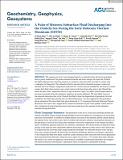Files in this item
A pulse of meteoric subsurface fluid discharging into the Chukchi Sea during the Early Holocene Thermal Maximum (EHTM)
Item metadata
| dc.contributor.author | Kim, Ji-Hoon | |
| dc.contributor.author | Hong, Wei-Li | |
| dc.contributor.author | Torres, Marta E. | |
| dc.contributor.author | Ryu, Jong-Sik | |
| dc.contributor.author | Kang, Moo-Hee | |
| dc.contributor.author | Han, Dukki | |
| dc.contributor.author | Nam, Seung-Il | |
| dc.contributor.author | Hur, Jin | |
| dc.contributor.author | Koh, Dong-Chan | |
| dc.contributor.author | Niessen, Frank | |
| dc.contributor.author | Lee, Dong-Hun | |
| dc.contributor.author | Jang, Kwangchul | |
| dc.contributor.author | Buchanan Rae, James William | |
| dc.contributor.author | Chen, Meilian | |
| dc.date.accessioned | 2022-01-29T00:38:56Z | |
| dc.date.available | 2022-01-29T00:38:56Z | |
| dc.date.issued | 2021-07-29 | |
| dc.identifier | 275120079 | |
| dc.identifier | 0fd5d055-ab6f-41d9-bee5-78108dc4d1ab | |
| dc.identifier | 85113742864 | |
| dc.identifier | 000691021600020 | |
| dc.identifier.citation | Kim , J-H , Hong , W-L , Torres , M E , Ryu , J-S , Kang , M-H , Han , D , Nam , S-I , Hur , J , Koh , D-C , Niessen , F , Lee , D-H , Jang , K , Buchanan Rae , J W & Chen , M 2021 , ' A pulse of meteoric subsurface fluid discharging into the Chukchi Sea during the Early Holocene Thermal Maximum (EHTM) ' , Geochemistry, Geophysics, Geosystems , vol. 22 , no. 8 , e2021GC009750 . https://doi.org/10.1029/2021GC009750 | en |
| dc.identifier.issn | 1525-2027 | |
| dc.identifier.other | RIS: urn:144B989494F99902F0350425A0B45F41 | |
| dc.identifier.other | ORCID: /0000-0003-3904-2526/work/97885275 | |
| dc.identifier.uri | https://hdl.handle.net/10023/24775 | |
| dc.description | This work was supported bythe Korea Ministry of Science and ICT (GP2020-038), by the Korea Ministry of Oceans and Fisheries (NP2011-040 and 1525011795), and by the Korea Polar Research Institute (Grants No. PE20350). W.-L.H. acknowledges the supports from the ArcticSGD, a project supported by the Norway Grants and the EEA Grants (2019/34/H/ST10/00645). Additional funds were contributed by the AWI Research Program PACES-II Workpackage 3.1 and 3.2. | en |
| dc.description.abstract | The response of Arctic Ocean biogeochemistry to subsurface flow driven by permafrost thaw is poorly understood. We present dissolved chloride and water isotopic data from the Chukchi Sea Shelf sediments that reveal the presence of a meteoric subsurface flow enriched in cations with a radiogenic Sr fingerprint. This subsurface fluid is also enriched in dissolved inorganic carbon and methane that bear isotopic compositions indicative of a carbon reservoir modified by reactions in a closed system. Such fluid characteristics are in stark contrast with those from other sites in the Chukchi Sea where the pore water composition shows no sign of meteoric input, but reflect typical biogeochemical reactions associated with early diagenetic sequences in marine sediment. The most likely source of the observed subsurface flow at the Chukchi Sea Shelf is from the degradation of permafrost that had extended to the shelf region during the Last Glacial Maximum. Our data suggest that the permafrost-driven subsurface flow most likely took place during the 2-3 oC warming in the Early Holocene Thermal Maximum (EHTM). This time scale is supported by numerical simulation of pore fluid profiles, which indicate that a minimum of several thousand years must have passed since the cessation of the subsurface methane-bearing fluid flow. | |
| dc.format.extent | 20 | |
| dc.format.extent | 3172330 | |
| dc.language.iso | eng | |
| dc.relation.ispartof | Geochemistry, Geophysics, Geosystems | en |
| dc.subject | Subsurface meteoric fluid discharge | en |
| dc.subject | Arctic element/carbon cycle | en |
| dc.subject | Permafrost | en |
| dc.subject | EHTM | en |
| dc.subject | Chukchi Sea | en |
| dc.subject | GE Environmental Sciences | en |
| dc.subject | DAS | en |
| dc.subject | SDG 14 - Life Below Water | en |
| dc.subject.lcc | GE | en |
| dc.title | A pulse of meteoric subsurface fluid discharging into the Chukchi Sea during the Early Holocene Thermal Maximum (EHTM) | en |
| dc.type | Journal article | en |
| dc.contributor.sponsor | NERC | en |
| dc.contributor.institution | University of St Andrews. School of Earth & Environmental Sciences | en |
| dc.contributor.institution | University of St Andrews. Centre for Energy Ethics | en |
| dc.contributor.institution | University of St Andrews. St Andrews Isotope Geochemistry | en |
| dc.identifier.doi | https://doi.org/10.1029/2021GC009750 | |
| dc.description.status | Peer reviewed | en |
| dc.date.embargoedUntil | 2022-01-29 | |
| dc.identifier.grantnumber | NE/M004619/1 | en |
This item appears in the following Collection(s)
Items in the St Andrews Research Repository are protected by copyright, with all rights reserved, unless otherwise indicated.

